The post The History of Electric Bikes and the Bicycle appeared first on eRide Guides.
]]>A German baron named Karl Von Drais made the first significant development in 1817 – but the bicycle was mostly a clunky wooden prototype that could only be powered by legs kicking the ground.
To truly understand the relationship between the traditional bicycle and the electric bike, it’s essential to study the history of all pedelecs. Although e-bikes were a concept in the 1890s, it wasn’t until the 1990’s that batteries were light enough to power them.
Let’s look at the earliest unverified bicycle, the invention of what we know as a ‘bicycle’ and it’s many improvements.
Finally, we’ll look at the electric bike and its switch from a bulky clunky transportation device to the incredible piece of technology it is today.
The Unverified History of the Bicycle
Before 1817, many inventors sketched up the concept of a bicycle. To qualify a piece of technology as a ‘bicycle,’ it has to be a human transport device with two wheels that requires balancing by the rider.
A sketch done around 1500 AD attributed to Gian Giacomo Caprotti, a pupil of Leonardo da Cinci, was discovered in the modern era.
After some research by bicycle historian Hans-Erhard Lessing, it was determined to be a purposeful fraud.
However, philologist and lexicographer Prof. Augusto Marinoni said otherwise. When he was tasked to look through the transcription of Leonardo’s Codex Atlanticus (a twelve-volume collection of DiVinci’s drawings), he determined it was likely an accurate drawing (see drawing here).
Another unverified drawing comes from a mostly undocumented artist Comte de Sivrac who developed something called the célérifère (see here) in 1792.
It resembled a Hobby Horse, had a seat, two wheels, and handlebars that could turn the front wheel. The rider would push the célérifère by pushing it along with their legs and feet.
Current historians state that there is no proof that the two-wheel célérifère existed, although there were four-wheeler versions.
The design was misinterpreted by Louis Baudry de Saunier, a well-known French journalist in 1891 while doing a collum for bicycle history.
The Birth of the Bicycle: 1817 to 1819
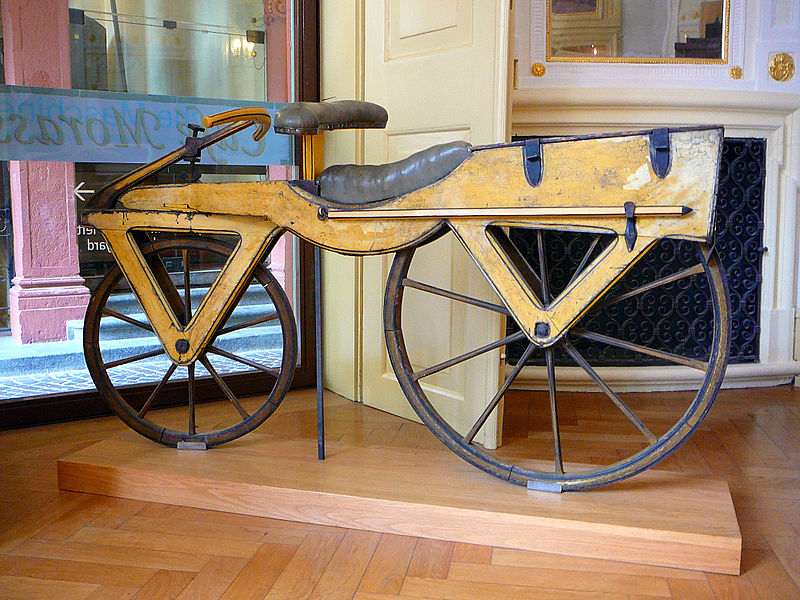
Photo Courtesy: Gun Powder Ma/Wikipedia
Baron Karl von Drais
The first bicycle belonged to Baron Karl von Drais, who acted as a civil servant to the Grand Duke of Baden. Called the Laufmaschine, Draisine, or draisienne, this wooden bicycle was created in 1817 and patented the next year.
It was the first commercially successful two-wheel, steerable, human-powered machine that was later re-branded as the velocipede and often called the dandy horse or hobby-horse. It was documented that Drais wanted a new type of vehicle to reduce the reliance on horses.
On Drais’s first ride from Mannheim, he covered 8 miles (13 km) in less than an hour.
Constructed mostly of wood, the Laufmaschine weighed 48 lbs and had wheel bearings, iron-shod wheels, brass bushings, and rear-wheel brakes.
Its popularity took off, but authorities soon limited its use because of the multiple accidents it caused. Still, many other inventors tried their hand at making new patented pedantic machines like the pedestrian curricle or the velocipede.
Denis Johnson
However, the name didn’t stick. It wasn’t until the modern era that the word “bicycle” became a familiar name.
Hobby horse was popular as it resembled the children’s toy, and the dandy horse was used as a cheeky way to make fun of the foppish English men that frequently rode them.
Denis Johnson’s invention in 1818 was more elegant because of its serpentine shape instead of the straight Drais model.
In 1819, the hobby-horse became the next big craze in London but was cut short when dandies noticed their boots getting worn down during riding.
Regardless, Drais’s velocipede provided the basis for all other bicycles to follow. Later, a French metalworker in 1863 created the rotary cranks and pedals to the front wheel hub, which ushered in the birth of the bicycle as we know today.
Scottish Two-Wheel Inventions: 1830s
One of the first mechanically propelled two-wheel vehicles belonged to inventor Kirkpatrick Macmillan, a Scottish blacksmith who made his invention in 1839. His nephew confirmed that his uncle developed a rear-wheel-drive design using mid-mounted riddles that connected with rods to a rear crank.
The Tretkurbelfahrrad by Philipp Moritz Fisher: 1850s
Another German was in the center of a new invention. Philipp Moritz Fischer used the draisine at a young age to travel to and from school.
He created the first bike with pedals (called the Tretkurbelfahrrad) in 1853, which didn’t require the user to propel themselves with their legs.
Boneshaker or Velocipede: 1860s

Photo Courtesy: Unknown author/Wikipedia
French inventors changed the design of the velocipede in 1863. It used rotary cranks and pedals mounted to the front wheel. It was difficult to steer, but it was possible to hit faster speeds due to the pedals positioning and the reduced weight of the metal frame.
These new additions made it possible to mass-produce the vehicle. Now, braking was possible due to the added metal components. In England, the velocipede earned the nickname “boneshaker” due to how it shook when riding on cobblestone rodes.
A patent made by Pierre Lallement means that the invention of pedals was given to him, although Fisher created pedals years earlier. Lallement’s patent drawing shows a machine that looks similar to Johnsons but with pedals and a rotary crank in 1866.
In the early 1860s, Pierre Michaux started producing parts for the velocipede on a large scale and created the Michaux company, which mass-produced bicycle parts. They dominated the industry for many years.
High-Wheel Bicycle: 1870s
The penny-farthing was the next big leap in bicycle innovation. It was high off the ground, contained one large wheel in the front and a small one in the back, and was capable of higher speeds and were primarily considered unsafe.
At this point, the bicycle was considered a high-class symbol. It was priced way out of the range of an average working-class worker until the 1890s, where the price decreased significantly due to the accessibility of parts.
Safety Bicycle: 1880s and 1890s
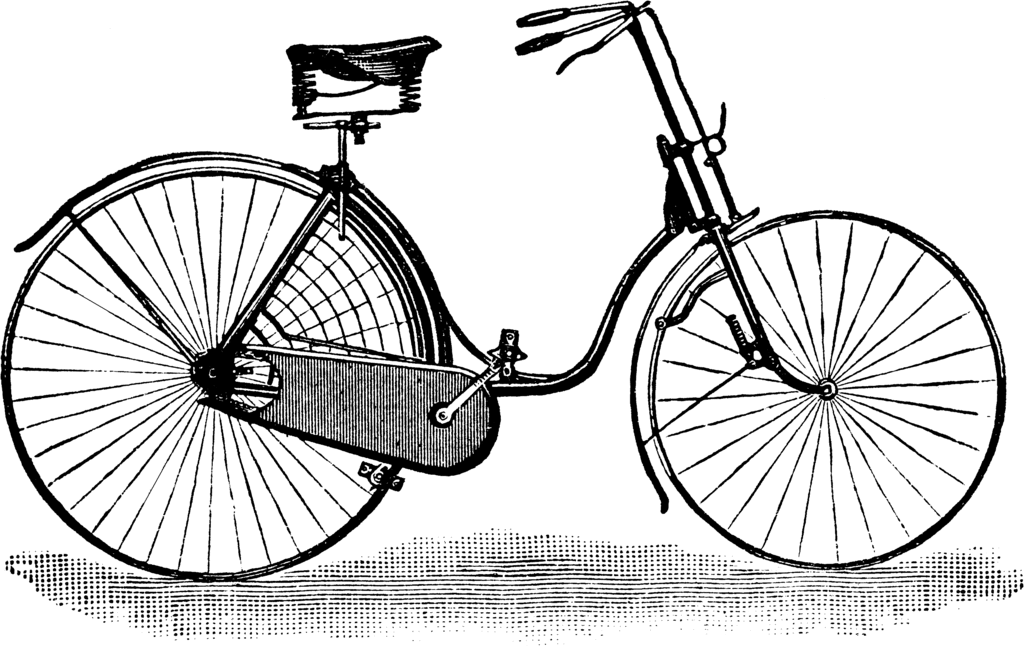
Photo Courtesy: Unknown author/Wikipedia
The safety bicycle is widely thought of as the most critical change in the history of the bike. It shifted the way others saw bicycling as a dangerous hobby to an everyday transportation tool that anyone of any age could enjoy.
Although there were still safety issues with the original safety bicycle of 1884 (as it was still too high off the ground), it added a chain-drive front wheel. Inventors later experimented with a rear-wheel chain drive.
John Kemp Starley produced the first successful safety bicycle called the ‘Rover’ in 1885 but wasn’t patented. It had a steerable front wheel with a large caster and equally sized wheels and a chain drive to the rear wheel.
The Rover was imitated countless times and wholly replaced the high-wheeler as it was easier to ride on paved streets and dirt roads. However, it wasn’t as comfortable as the high-wheelers because of the smaller wheel size and lack of suspension.
John Dunlop’s reinvention of the pneumatic bicycle tire helped create a smoother ride and made the complicated bicycle suspension obsolete. This also meant the diamond pattern became the most efficient design, which was later foldable after African American inventor Issac R Johnson lodged a patten for his design.
The chain drive improved speed and comfort, which allowed for a smooth, relaxed, and injury-free pedaling experience. Riders could easily steer around corners due to its lighter design and simple construction.
The Invention of the Electric Bicycle: 1890s
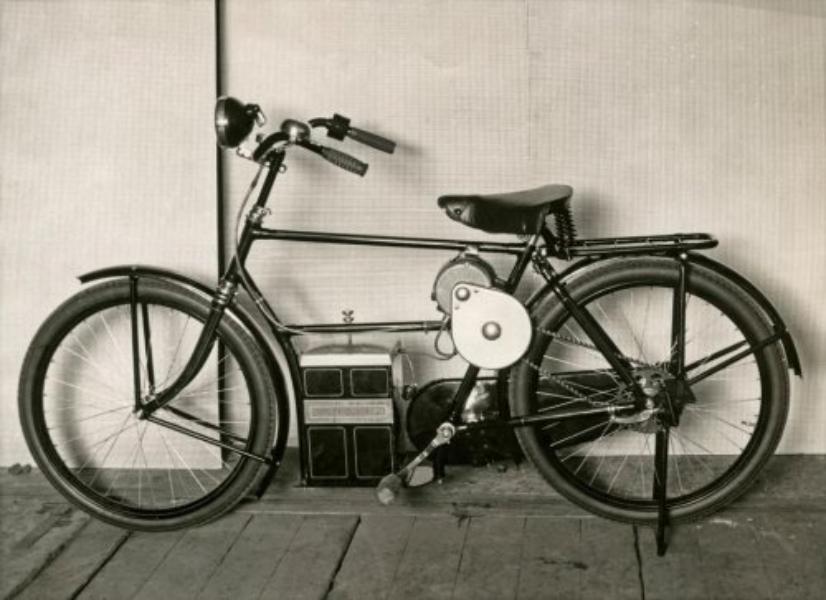
Photo Courtesy: GaHetNa (Nationaal Archief NL)/Wikipedia
Electric bikes were documented within various U.S. patents. In 1895, Ogden Bolton Jr. created a patent for the first battery-powered bicycle with a 6-pole brush-and-commutator direct current hub motor mounted at the rear wheel.
At the time, this electric bicycle had no gears, and the motor could draw up 100 amperes from a 10-volt battery. It was very clunky and barely moved. All human-powered bikes at the time could maintain faster speeds that this primitive e-bike.
In 1897, Hosea W. Libbey invented an electric bike that propelled by using a double electric motor. It was designed within the hub of the crankset axle. This was reinvented in the 1990s by Giant Lafree e-bikes.
1898 saw a rear-wheel-drive e-bike that used a driving belt, and 1899 depicted a roller wheel style electric bicycle. Until the 1960s, electric bike inventions remained stagnant because the batteries and frames were too clunky, and the battery lasted less than an hour.
The Last of the 19th Century: Roadsters
By the 1890s, the roadster was pattened and well documented. Its design included a step-through frame rather than the diamond shape that the gentleman’s model had. This made it easy for ladies to mount the bicycle with dresses and skirts.
The frame was made of steel, the spokes were positioned lower (so dresses and skirts wouldn’t get caught) and had functional coaster brakes, drum brakes, or rim brakes. This design grew rapidly and was nicknamed the Dutch cycle, as 85% of all roadsters were produced in the Netherlands. The primary demographic was the British.
However, the decline of all bicycles was starting to occur – though mostly in the United States. There was a slight decline in the 1900s for Europe, but it still remained strong throughout the 1900s – 1940s.
The Decline in US Popularity in the Bicycle Market
Even to this day, Europeans still love the bicycle and the freedom it gives to its people. On the other end of the pond, the United States fell out of love with the bicycle, and its many renditions and innovations.
Automobiles became the most preferred means of transportation due to their comfort. The average person didn’t need to use their own kinesthetic power to move a transportation device, which was attractive to many Americans – especially with the upper-class.
In the 1920s, bicycles were gradually becoming children’s toys, and by the 1940s, most bikes were made for children. Europeans kept cycling as a mostly adult activity, and hobbies like bicycle racing, commuting, and cyclo-touring became popular activities.
Even after the invention of the automobile and motorcycle, the bicycle remained the preferred mode of transportation for Europeans. Manufacturers such as Raleigh, BSA, Philips, Carton, Hercules, and Rudge-Whitworth monopolized the market.
Technical Innovations: 1900s to 1930s
Although there was stagnation compared to other years, bicycles continued to develop throughout the early 20th century. France developed many cyclo-tourist ventures for tourists, and in the 1930s, European racing organizations started to pop up.
Gearing and the ability to shift gears became vogue. Now, the rear wheel had a sprocket on either side of the hub. Unlike modern models, riders had to stop, remove the wheel, flip it around and remount it to change gears.
World War II and Military Usage: 1940s
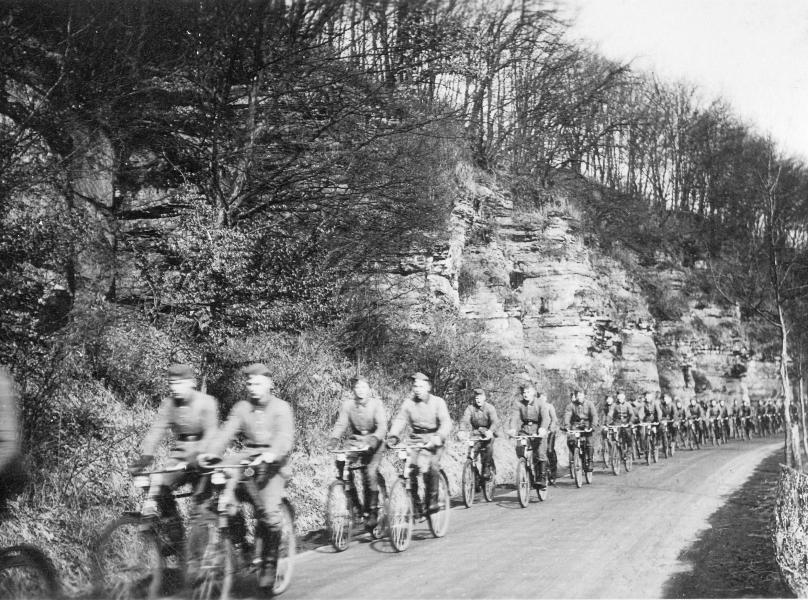
Photo Courtesy: BreTho/Wikipedia
Although there were multiple-speed bicycles available on the market, military bicycles were single-speed. Paratroopers would drop bicycles to military men for their use, which created the term “bomber bikes.”
Many units specifically used bicycles as a means for transportation, like the German Voksgrenadier. Their Invasion of Poland saw 196 bikes and 1 motorcycle. 41 companies specifically created bicycles for infantrymen.
The Japanese used over 50,000 bicycle troops during the Malayan Campain. They were so popular and needed for Japanese military men that they confiscated them from Japanese citizens for their use. They would often carry 80 pounds of equipment while riding, whereas a British soldier could only carry a maximum of 40 pounds.
The Flying Pigeon in China: 1950s/1960s to 1980s
One interesting point in the history of the bicycle was the invention of the flying pigeon, although it looked similar to all other 1950s cruisers at the time. It became a massive phenomenon in the People’s Republic of China and was one of the only government-approved means of transport.
The Flying Pidgeon became a status symbol to Chinese citizens along with a sewing machine and the watch. If you had all three, it meant that you were a well-to-do and classy person who has a significant amount of wealth. Chinese citizens couldn’t buy them fast enough.
During the 1960s and 1970s, the Flying Pidgeon logo became the most popular mechanized vehicle on the planet. In 1986, over 3 million cycles were sold, and there was an incredibly long waiting list for a black model popular with workers. You needed to have good guanxi (loosely translated to connections and or relationships) to even purchase one.
The North American Cruiser and Racer: 1950s, 1960s, 1970s
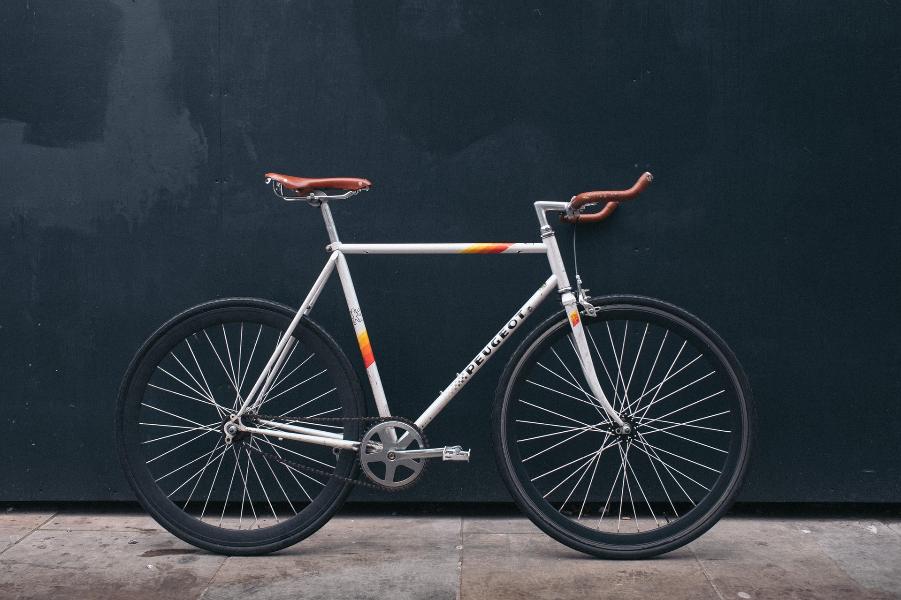
Photo Courtesy: Robert Bye/Unsplash
In Noth America, the cruiser and racer were among the most popular bicycle style. The cruiser, which was popular with hobby cyclists, had pedal-driven brakes, one gear, and balloon tires that helped with shock absorption. It was popular because of its comfort and durability.
Also in the 1950s, the racer became incredibly popular in North America. The racer, also called the sports roadster by Americans, became popular with adult cyclists that wanted an alternative to the cruiser. It was faster and better at climbing hills because of its lighter weight, narrow tires, multiple gears, and tall wheels.
There was another surge in popularity for bicycling in the 1960s thanks to interest in exercising and an attitude shift to more energy-efficient transportation sources. This led to the 1970s bicycle boom, wherein 1975, over 17 million units were sold to Americans.
Increased sales were due in part to new cyclists who preferred European style bicycles, which were called ten-speeds, sport/tourers, or sports models. These lighter models were popular with racers and cycling enthusiasts.
California and the Invention of BMX Bikes: 1970s
For a long while, the bicycle looked pretty much the same until the BMX was invented in California in the 1970s. The wheels ranged from 16 to 24-inches and were popular with teenagers because they wanted to imitate riding a motorcycle.
At the time, the Netherlands imported BMXs to race around the road, which spawned the racing documentary On Any Sunday. It credits the BMX with the motorcycle boom of the 1970s and the popularity of BMXing as a sport, rather than just a hobby.
California and the Invention of Mountain Bikes: 1970s
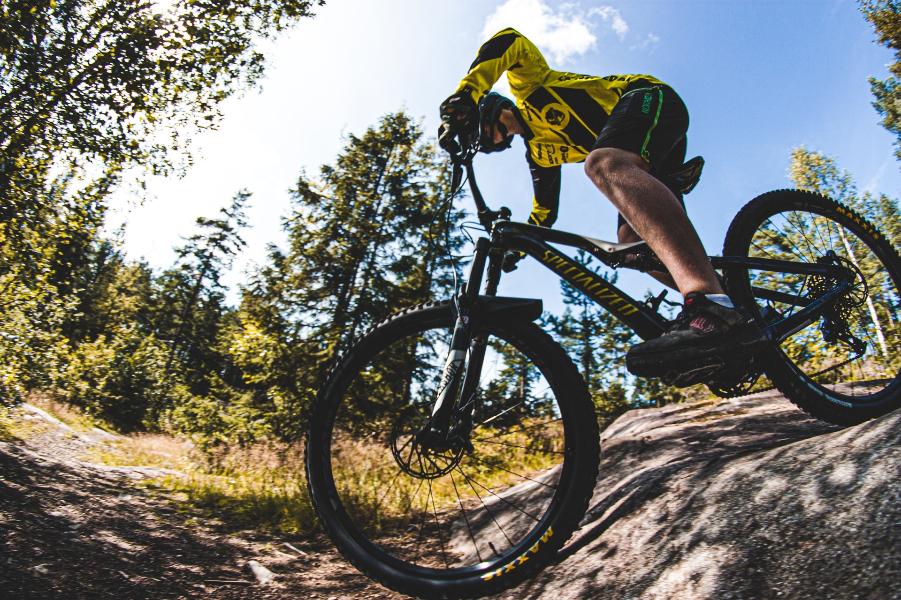
Photo Courtesy: Tobias Bjerknes/Unsplash
Another California invention, the mountain bike, first appeared in the 1970s but wasn’t mass-produced until 1981. The mountain bike’s intended use was for off-pavement or bumpy surfaces found during off-roading.
It was a quick success, as it encouraged urban dwellers to escape their surroundings and inspired other extreme sports. Mountain bikes had a more upright seating position and better front and rear suspension.
The European Bicycle Market: 1970s – 1990s
The British utility roadster was declining in popularity in the 1970s as recreational cycling became more popular. Now, lightweight bikes that weigh less than 30 pounds were the most affordable sportbike on the market and were also used for racing.
Swedish manufacturer Itera invented a bicycle made entirely out of plastic, but it failed. Instead, the U.K. switched from road-only to all-terrain bicycles. Mountain bikes were incredibly popular because of their versatility. By 1990, the roadster was practically dead.
Developments in the E-Bike Sphere: 1990s – 2000s
Unlike the traditional bike, the history of the e-bike spans only 40 combined years. Recently, e-bikes have exploded in popularity because of their lower price and accessibility. Yamaha built one of the earliest prototypes in 1989, which looks very similar to the modern e-bike.
Power controls and torque sensors were developed in the 1990s, while Vector Service Limited created and sold the very first e-bike called Zike in 1992. It included a NiCd battery that was built into the frame and included an 850 g magnet motor. However, there were barely any available, and it isn’t clear why. It may be because they were expensive to produce.
Yamaha invented the first pedal-assist system in 1993. On the other side of the world, American car icon Lee Iacocca founded EV Global motors in 1997. EV Global produced an e-bike named E-bike SX, and it was one of the earliest efforts to popularize the concept.
Bulky e-bikes at the time had lead-acid batteries, while new models adopted NiMH, NiCd, and lithium-ion. Lithium-ion was one of the most important breakthroughs in e-bike technology because it helped to increase the speed and range of the vehicle.
Modern Day E-Bikes and Their Surge in Popularity
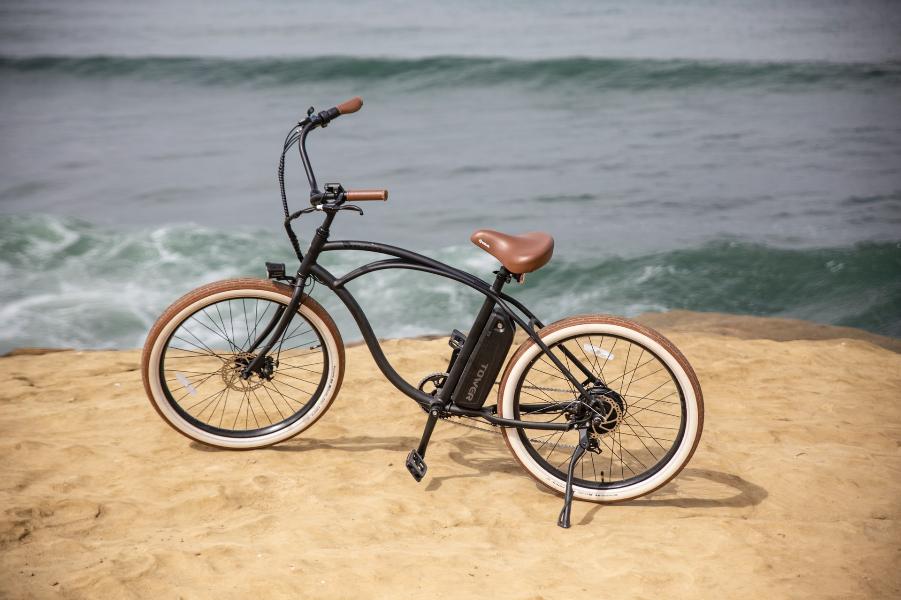
Photo Courtesy: Tower Electric Bikes/Unsplash
In 2001 electric bicycles were popular enough to have nicknames such as pedal-assisted, pedelec bikes, power bikes, and power-assisted bicycles. Now, the term e-motorbike or electric motorcycle refers to models that exceed 50 mph (80 km/h)
In 2007, e-bikes were thought to make up 10 to 20 percent of the market, while now they make up about 30%. A typical unit has an 8-hour charge battery, an average range of 15-25 miles, and can hit speeds of 20 mph (36 km/h).
There are currently multiple classes for e-bikes, including class 1, class 2, and class 3, which each determines where you can ride them and whether or not you need a license. Although this is implemented in Europe, these laws only exist in a few US states.
The Popularity of the Modern E-Bike
Since 1998, e-bike usage has seen rapid growth. China is the world’s largest producer of e-bikes, according to data from the China Bicycle Association. In 2004, China sold over 7.5 million e-bikes worldwise, which doubled from the previous year.
There are over 210 million electric bikes used daily in China, which is said to increase to 400 million in the next 10 years. In Europe, over 700,000 e-bikes were sold in 2010, but that number rose to 2 million in 2016. Now, the EU has implemented a 79.3% protective tariff on imported Chinese e-bikes to protect EU producers who seek to keep Europe as a primary market.
Are you an e-bike enthusiast?
Are you interested in many other articles, like this one, that gives an in-depth history of bicycle history?
Browse the site for more information on the best electric bikes and scooters that can make your commute more stylish and fun.
Before you go, leave a comment on what you think about the history of e-bikes and bicycles in general, or read one of our other articles about e-bikes.
The post The History of Electric Bikes and the Bicycle appeared first on eRide Guides.
]]>The post Electric Bikes vs. Regular Bikes: The Differences Explained appeared first on eRide Guides.
]]>At first glance, they look very similar to each other but, upon closer inspection, you can start to see how the technology on the e-bike is just as different as it is similar to a regular bike.
To put it simply, an electric bike is a regular bike with an added drive system. The drive system consists of a motor, battery, and a way to steer the motor’s power into the drivetrain. Although the cost of an electric bike is similar to a regular bike, maintenance on an electric bike is often more expensive. However, the speed of a traditional bike is usually a lot lower for typical users.
Let’s take a closer look at the attributes that truly set the two bikes apart, including speed, rules and regulations, riding experience, appearance, and maintenance.
First, let’s look at the history of the traditional bike and its electric counterpart.
Over 200 Years of Bicycle History
Overview
In 2017 the bicycle celebrated it’s 200 birthday. The bikes’ impact on our culture and tradition is unprecedented because it created mobility where there previously wasn’t.
Although the automobile took a significant portion of the traditional bikes market share, it wasn’t until the e-bike that the regular bike saw a substantial cut in its profits.
With over one billion bicycles in the world, the traditional bike is the most common mode of transport worldwide by a large margin. The passenger car looks meager in comparison to only 500 million.
Looking at Germany, there are over 81 million bikes and only 45 million cars, with 3 million of those bikes consisting of electric bikes, scooters, or other electric assisted vehicles.
It’s easy to see why bikes have gained popularity in part of its mobility and economical design. The bicycle quickly replaced stagecoaches and turned nobility on its head.
No longer were the bourgeoisies the only class that could comfortably ride long distances. It’s likely that without the traditional bike, automobiles wouldn’t exist in their current form.
The Invention of the Traditional Bicycle
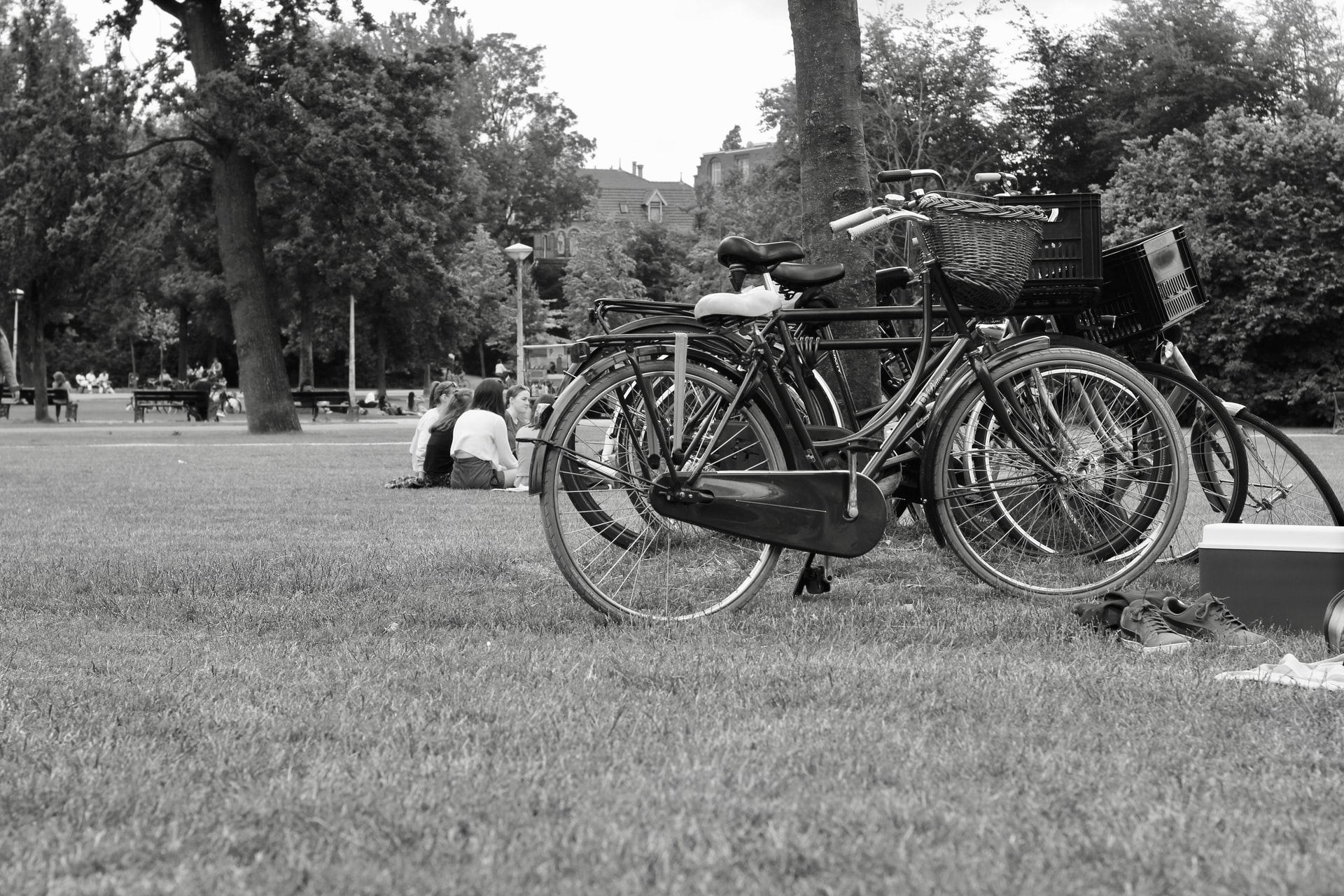
Photo Courtesy: Louis Hansel @shotsoflouis/Unsplash
The first bike prototype was called the running machine or dandy horse created in 1817 by Karl Drais. It had no pedals and could only propel with kicking the road beneath it. In 1860, the crankset and pedals were mounted on the dandy horse by Pierre Michaux. The first bicycle prototype, created by John Kemp, was built in 1885.
Visionary Robert Bosch and the Bosch group are responsible for many add-on inventions to the modern bicycle. In 1890, Robert Bosch popularized biking in Germany and the rest of Europe by riding a High-Wheeler, which had a large front wheel and a tiny rear wheel for stabilization. In 1903, the hub gear system invented by Erst Sachs was the first mass-produced part.
Back to the Bosch company in 1923, the invention of the dynamo lighting system produced over 20 million units by the 1960s and allowed commuters to bike at night.
The derailleur system, invented by Tullio Campagnolo in 1948, was a style-setting influence for years to come – even during the birth of the mountain bike in 1973.
In the modern area of 1993, Yamaha mass-produced the crank-drive pedelec motor to support and reinforce active pedaling.
Since then, inventions have been focused on e-bikes. Regardless of which bike is featured, Bosch has remained the European market leader in bicycles since 2013.
The Invention of the Electric Bicycle
Electric bikes don’t have as long as history as traditional bikes, but inventors have attempted to make e-bikes roadworthy since 1895, but it wasn’t possible until the modern era.
For one, the heavyweight of the electrically driven wheels coupled with the batteries’ low range made e-bikes useless until the invention of the lithium-ion battery in 1991.
It’s now possible to ride over 62 miles (100 km) on a single charge, and with the mass production of electric bikes, motors, and batteries, the technology is more accessible than it ever has been.
Pedelecs are actively shaping city landscapes and making us rethink how to use and maintain proper cities and transportation.
Technical Differences Between an E-Bike and Regular Bike
Electric bikes have electrical components, whereas a regular bike has mechanical components. They both work in similar ways, except the electric bike has the additional drive system, which consists of a motor, battery, a way to control the power, and a way to integrate said motor’s power into the drive train.
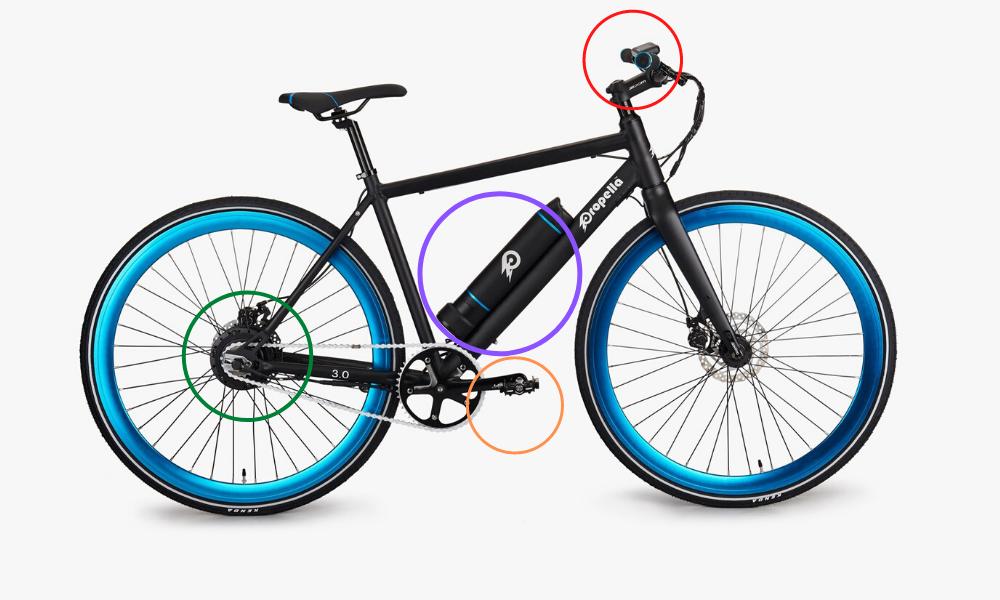
Photo Courtesy: Katrina Dent/Propella
Take a look at the Propella e-bike. It looks similar to a traditional bike, but the color circles indicate the electrical differences. The red circle highlights the throttle, the orange circle shows the mid-drive motor, the green circle is the drivetrain, while the purple circle is the battery that powers the motor in the rear.
Mid-Drive Motor
Although some e-bikes use hub-motors, the mid-drive motor was invented to improve on the short-comings of the hub-motor.
For one, mid-drive motors have a more significant gear ratio so that the rider can power the rear wheels with the same chain and gear set. Mid-drive motors are great for riding up steeper hills and are unlikely to overheat.
Weighing only 5 lbs, the mid-drive motor packs a lot of punch and acts as the motor to power the e-bike. Mid-drives allow for true torque sensors for pedal-assist systems (like the Propella) to regulate the motor power based on how hard you push.
Its center of gravity is close to the ground to improve handling while distributing the weight easier throughout the bike.
Battery
The most expensive and heavy component of the bike, the typical electric battery can provide up to 40 miles (64 km) of riding, but multiple factors determine the true scope, range, and power of the battery.
There are 4 common types of batteries on the market: lead-acid, nickel-cadmium, nickel-metal hydride, and lithium-ion.
Lithium-ion batteries are becoming the default battery because they produce more power output and weigh significantly less than the other options.
Most importantly, they’re durable and will last longer. Although this component is costly, it’s more than worth it because it knocks other batteries out of the park when it comes to range, weight, and longevity.
Drivetrain
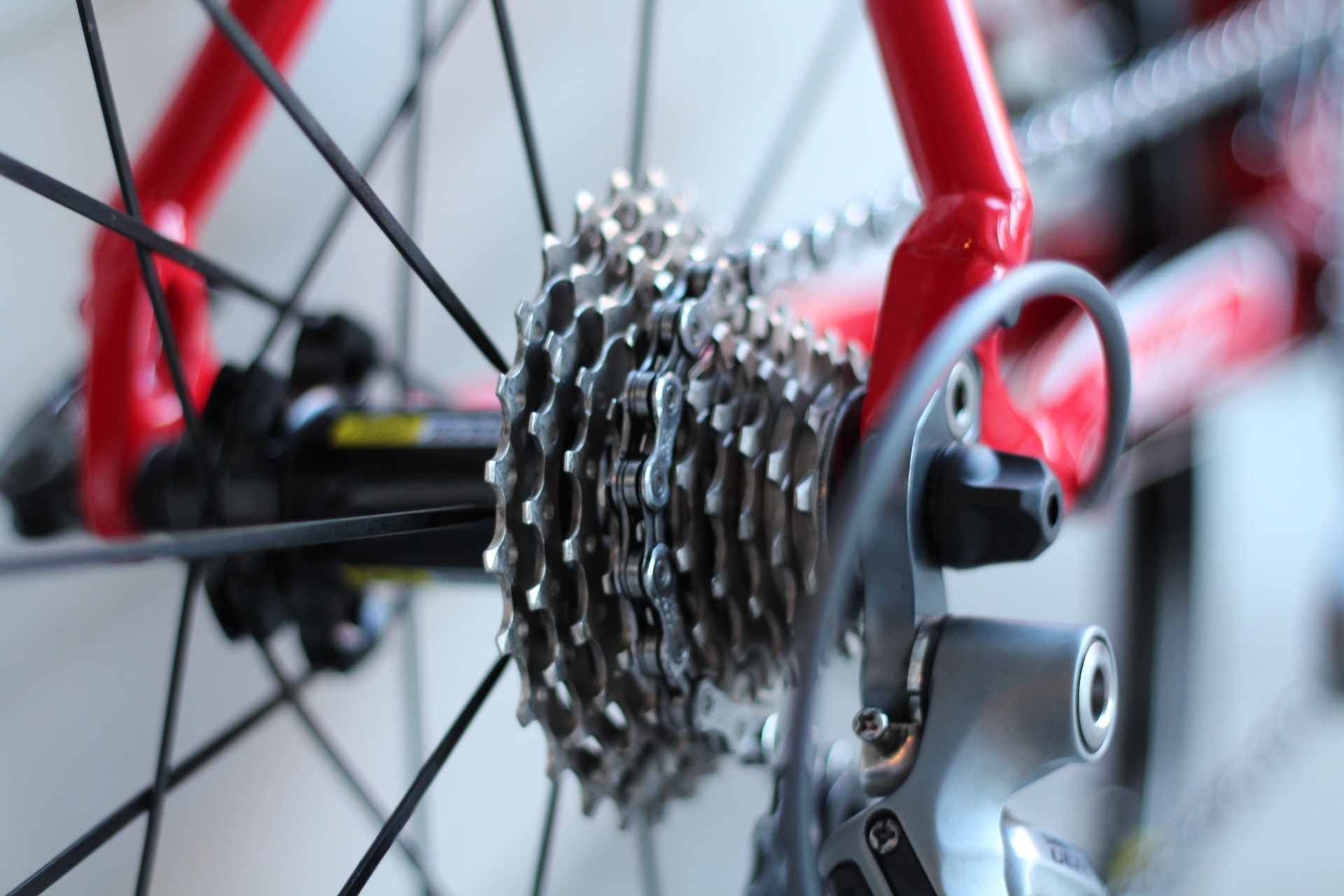
Photo Courtesy: Wayne Bishop/Unsplash
The drivetrain delivers power to the driving wheels and converts torque and speed via the gears. Many e-bikes on the market allow you to ‘turn up the dial’ to adjust the gears on the drivetrain, so you’re able to scale steeper hills.
To protect against accelerated wear on the drivetrain, the power in the motor is typically limited to around 250-500 watts.
A significant drawback of an e-bikes drivetrain is that it has to be charged (though not on a regular basis) while the traditional bicycle drivetrain doesn’t.
An uncharged drivetrain won’t be able to shift gears. As a benefit, the drivetrain, when charged, will remain consistent while switching gears because there are no cables that could slop or stretch over time.
Throttle
Most e-bikes have two modes: throttle mode and pedelec mode. Where the pedelec mode works similar to a traditional e-bike and uses pedals to propel forward, the throttle mode on an electric bike works identical to a motorcycle throttle.
The throttle engages the motor and provides power and moves you and the bike forward.
A throttle component allows e-bike users to sit back and let the bike do all the work. Some e-bikes allow for both the throttle and pedelec modes to engage at the same time.
This will enable commuters to go above the top speed of the bicycle while getting some exercise in the process. Not all countries allow for the throttle feature on bikes.
Except for the above 4 components, all other parts on an e-bike are the same as a traditional bike. E-bikes still have a frame, disc, brakes, two wheels, a seat, suspension, pedals (in most cases), and handlebars.
Electric Bike Display
It’s uncommon to find an electric bike with a display – especially if you’re riding anything under $1000. However, you can always buy an electronic bike display and hook it up to your battery and motor for accurate readings on the range, battery level, speed, distance, and trip distance. Traditional bikes hardly ever come with a display, and it typically isn’t as advanced.
More expensive e-bikes offer additional bike display features, such as tracking sat nav/GPS and fitness tracking. These displays can help you quickly interpret how many calories you’re burning in a session and location, as well as the overall health of your bike.
I recommend you purchase an e-bike with a display to better understand your e-bikes range, max speed, and battery level as it helps with general maintenance.
The Differences in Riding Experience
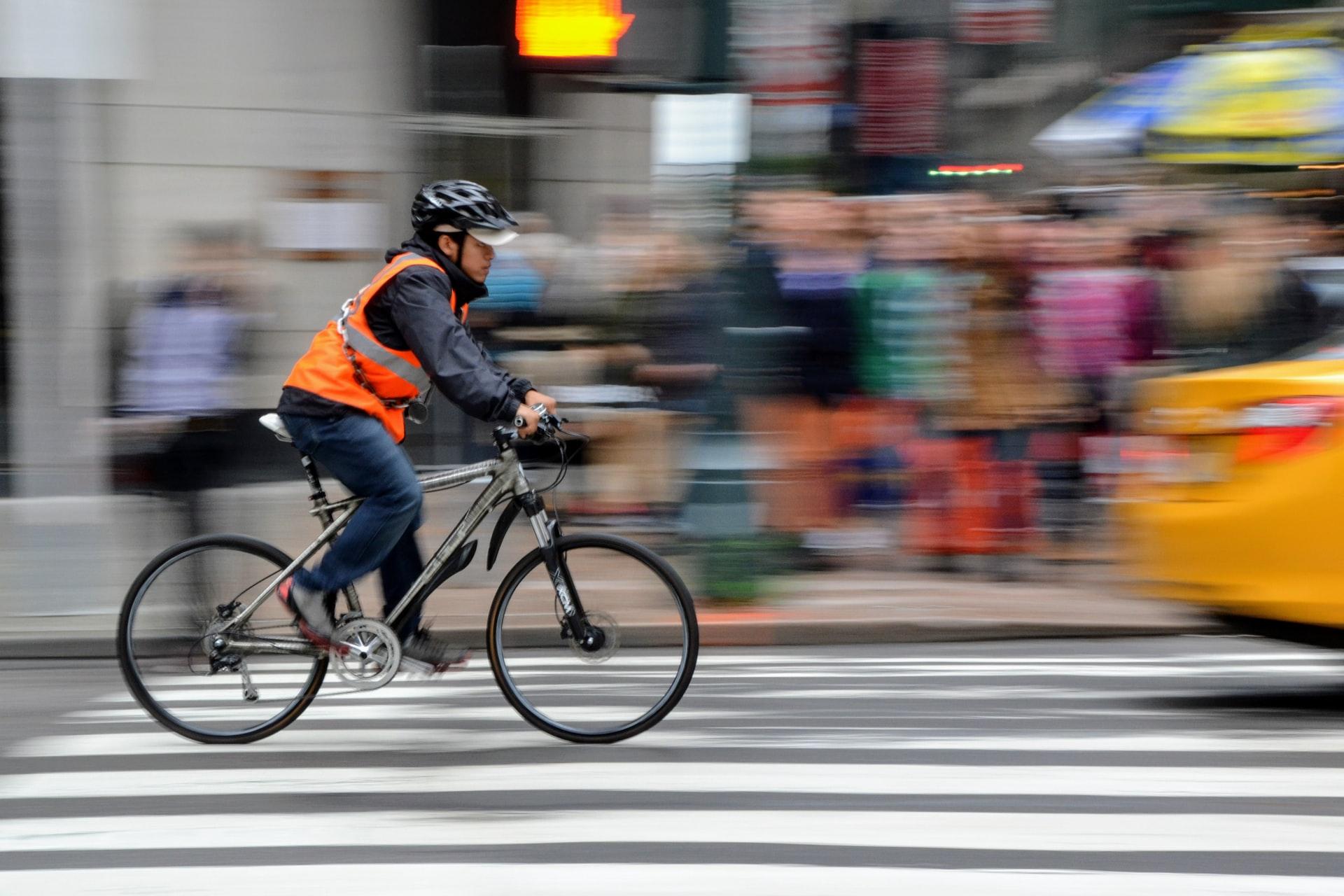
Photo Courtesy: Javier de la Maza/Unsplash
Although there aren’t many differences between an electric bike and a traditional bike, the riding experience can be vastly different. Whereas an e-bike commuter can choose not to use the throttle and ride it like a conventional, albeit a heavier bike, the traditional bike can only act as an ordinary bicycle and only use the pedals to propel itself.
The major shortcoming of a traditional bike is its accessibility. Maybe you want to be fit, but you’re not quite there yet. Perhaps you want to ride a bike to work to save on gas money, but you’re concerned about arriving to work sweaty.
Or, maybe a heart disease or other physical impairment prevents you from participating in a more active lifestyle.
The electric motor solves these problems. No matter how windy, how long, or how far your commute is, the motor will help you arrive at your destination.
If you want to bike, but halfway to your destination you’re exhausted, you can use the throttle to coast the rest of the way.
Riding a bike gives you the freedom to ride unencumbered by traffic or the size of the road. You also don’t have to worry about the price of gas (just electricity for an e-bike).
Electric bikes add that extra bit of freedom to all because it’s an accessible and fun activity.
Fitness vs. Convenience
Let’s get this out of the way: riding an e-bike, even one that isn’t pedal-assisted, isn’t cheating your health or fitness levels. The automobile was invented to solve the problem of a long-distance commute without the reliance on horses.
E-bikes fill that need for those who can’t afford cars in the big city while also providing a means of accessible transportation.
I’m a cyclist, but if I have to take a 40 mile (64 km) round-trip to a friend’s house or work, I reach for the car keys instead.
If I’m feeling tired, I’m more likely to use the path of least resistance, especially if the road ahead is hilly.
With an electric bike, I can make the same trip with minimal effort if I choose only to use the throttle. I can do errands easier, and quicker, because I don’t have to wait in traffic or find somewhere to park. It also saves me money on gas.
Instead of looking at a traditional bike vs. electric bike and riding vs. not riding, look at it as a fun, convenient, and accessible way to travel. With a pedal-assisted e-bike, I can also get my exercise in if I choose to.
Maintenance and Repairs
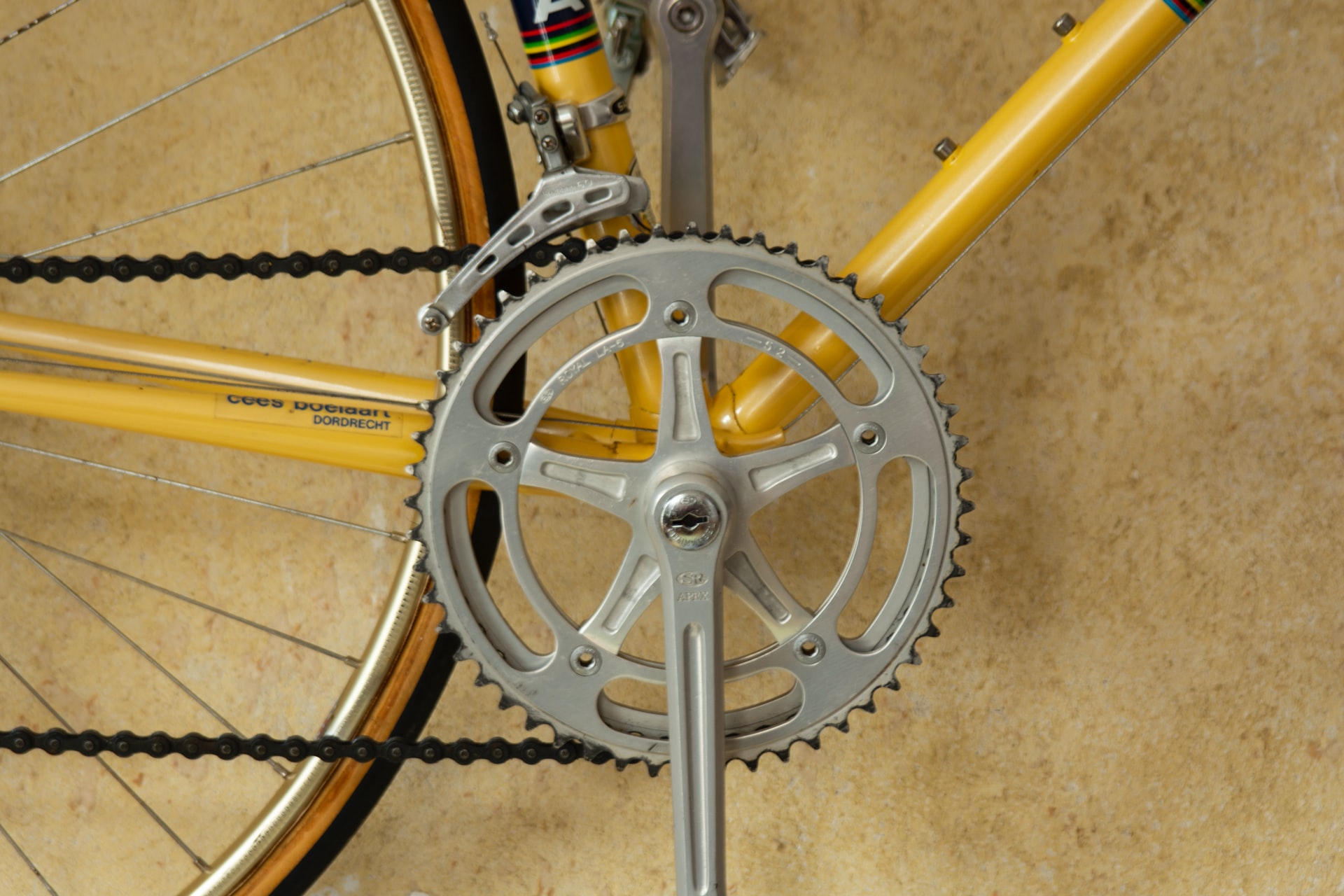
Photo Courtesy: Jeremias Radny/Unsplash
The traditional bike and e-bike require frequent maintenance, but the e-bike could cost more if the battery or motor is damaged. Overall, the cost of maintenance and repairs is similar.
Keep Your Bike Clean
Clean both your bike and e-bike regularly to maintain the look and overall health of your vehicle. Both the traditional bike and e-bike can use diluted dish soap and rags to wipe down the frame gently.
Try not to use soap or water on gears or other components that could rust, or they may erode and require a replacement.
While cleaning an e-bike, you will need to be more careful, or you risk damaging or destroying the electrical components. Always take the battery out, and clean carefully around the motor, battery container, and drivetrain.
Both the traditional bike and e-bike can be polished with a bicycle wax to add an extra layer of protection over the frame and paint.
Lubrication
To keep all gears in good working order, apply lubrication to the moving parts such as the chain and brake. Use a special cleaning solution to wipe off dirt or mud on these components before applying lubricant.
Both the traditional bike and e-bike need lubrication in the same locations once a week.
Inflate Tires
Both the traditional bike and e-bike need properly inflated tires at all times. It’s important to check tire pressure at least once a week and check tires for uneven wear or puncture holes.
E-bikes can come with airless tires, so tire pressure won’t be an issue in this case. However, it is still essential to check for wear on airless tires.
Check Brakes
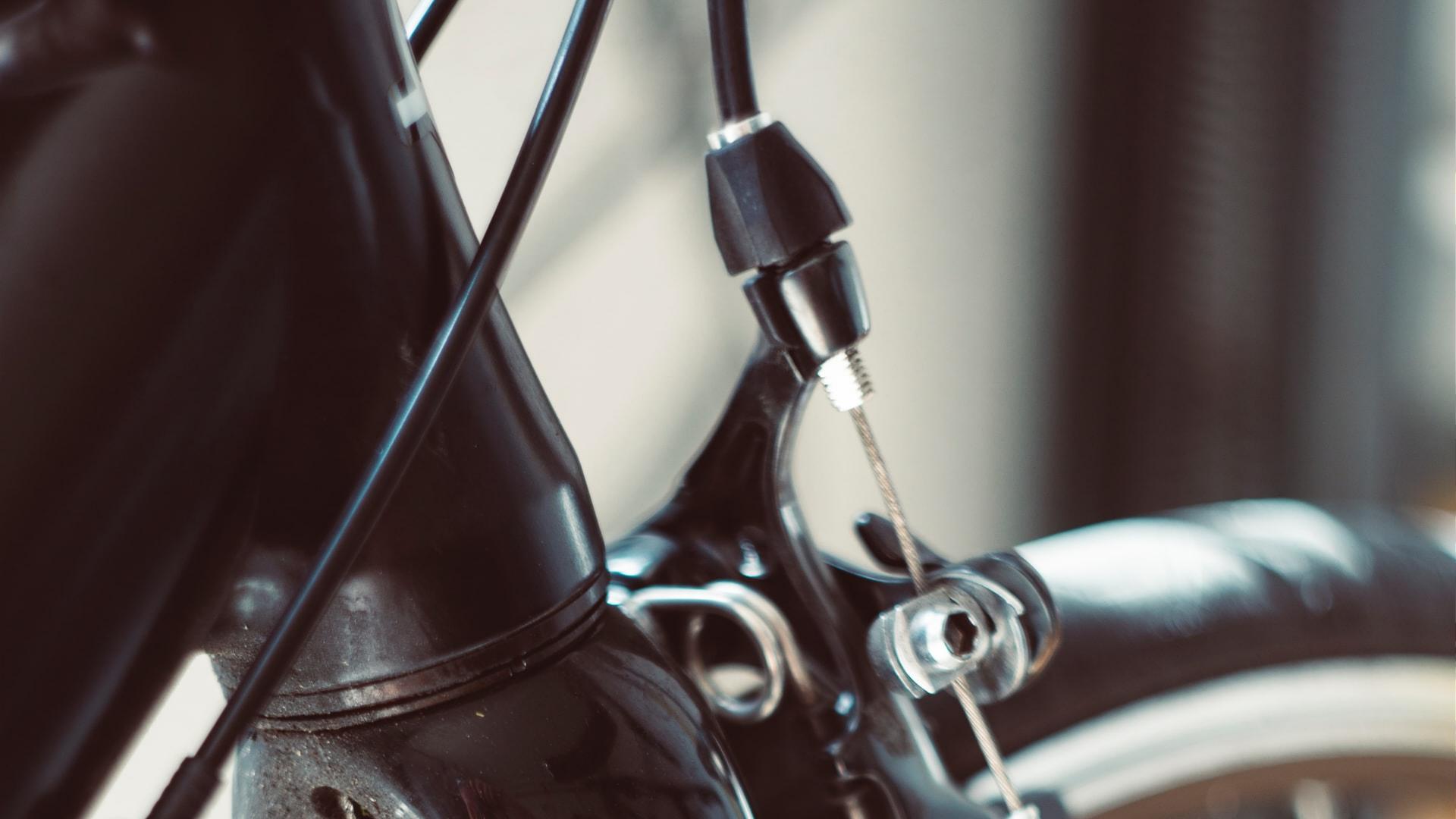
Photo Courtesy: Markus Spiske/Unsplash
On a traditional bike, the brakes are connected through a series of cables. Instead, an e-bike uses brake pads similar to an automobile to stop quicker at fast speeds.
For brake cables, check if there are any tears and that the connection isn’t loose or severed. For brake pads, check for wear and tear, and that the nubs on the pads aren’t too worn down.
To test either kind of brakes, ride at less than 8 miles (12 km/h) and pump the brakes. Notice how fast you stop and if you need to adjust the brakes stopping power.
It’s always better to test your brakes before riding (especially on an e-bike) to prevent potential accidents.
Tighten Nuts and Bolts
Every week, check all the nuts and bolts on your bike and tighten any that look loose. To quickly determine which nuts and bolts require tightening, use your fingers to try and loosen screws.
If they come apart easily, they are too loose and need a wrench to tighten them. Never use your fingers to tighten nuts, bolts, or screws because they won’t stay that way long-term.
Battery and Motor
Unique to the e-bike is maintenance on the battery and motor. Always read the manufacturer’s instructions to properly preserve both parts long-term.
Since battery and motor replacements are expensive, ensure that water, dirt, or dust doesn’t get inside its components. Always remove both parts during storage or in colder temperatures.
Average Speed

Photo Courtesy: Anthony Gilbert/Unsplash
As of writing this, the world record bicycle speed is 183.9 mph (295 km/h) broken by Denise Mueller-Korenek, 45, and with a draft provided by a dragster.
The average cycler doesn’t achieve speeds close to that at 9.6 mph (15.5 km/h) on a flat surface. A fit rider can maintain speeds of 25 mph (40 km/h), which is also the average speed of a moderately priced e-bike.
An e-bike, unless it’s rigged to do so, doesn’t exceed speeds of 40 mph (64 km/h) with a throttle. In the United States, an e-bike cannot exceed speeds of 28 mph (45 km/h) legally either on the sidewalk or street.
Although it is possible for a human-powered bicycle to exceed 28 mph and 40 mph, you cannot do so unless you’re exceptionally fit.
If you’re not racing, e-bikes might make your ride faster (and arrive at your destination less sweaty).
This is because the e-bike’s motor makes pedaling feel effortless so you won’t get tired as quickly. An e-bike also helps to maintain a constant speed.
Rules and Regulations
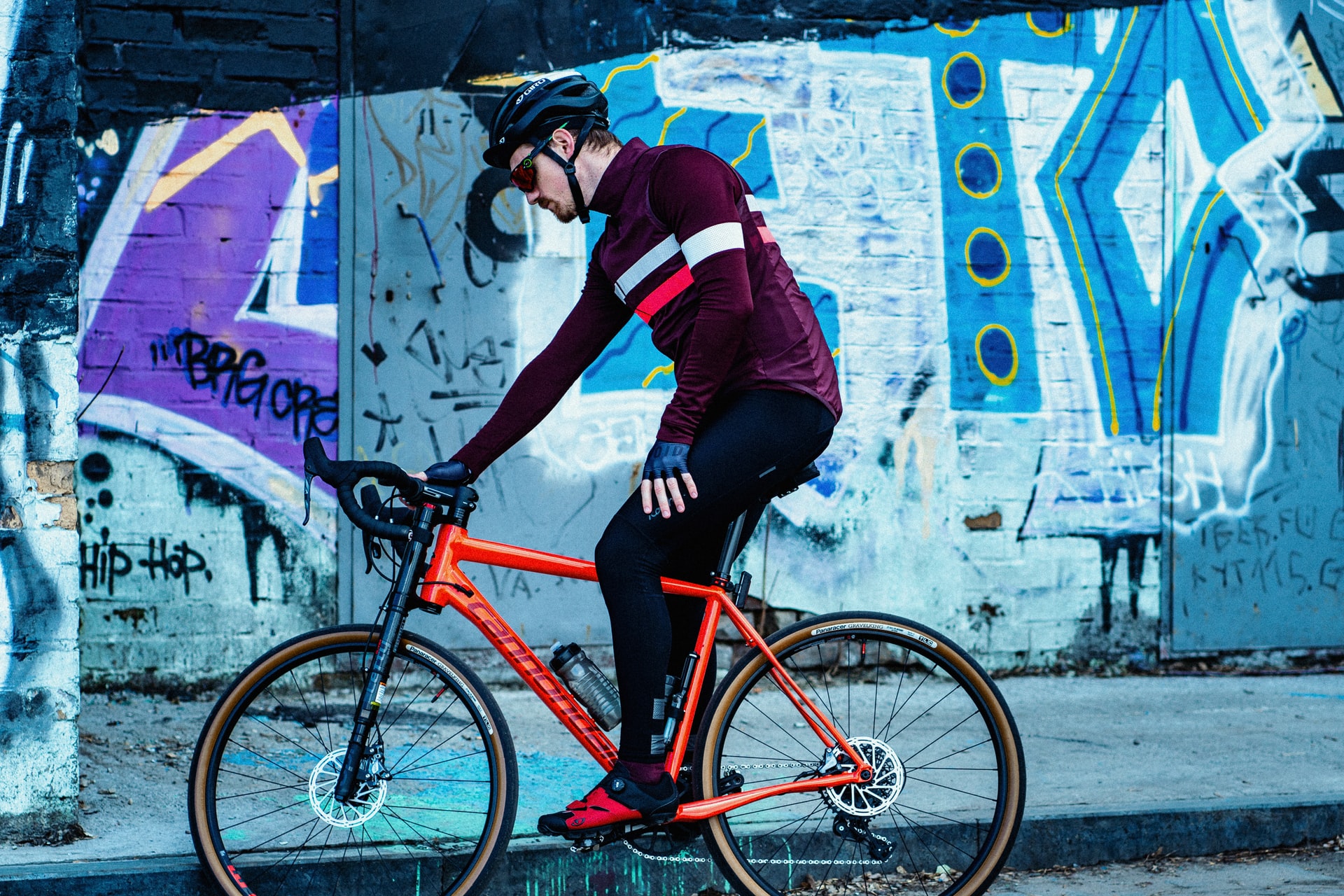
Photo Courtesy: Victor Xok/Unplash
Although there are rules and regulations for a traditional bike, these rules don’t carry the same weight if you break them compared to e-bikes.
Traditional Bike
In the US, all bicycles must have lights between sunset and sunrise to improve visibility and reflectors so other vehicles can see you. Brakes are also mandatory, but only one functioning brake is necessary for US bylaw.
The requirement to wear a helmet in the US varies based on jurisdiction and age, but it’s usually a good idea to wear on if you’re riding in traffic.
As a general rule in the United States, all bikes must ride on the right-hand side of the road and never against the traffic flow. You must occupy the same space as motor vehicles and never on the sidewalk unless there is a designated bike lane.
Since a bicycle is considered a slow-moving vehicle, you must position yourself as far right as possible so cars can pass you.
Hand signals are required to inform cars where you plan on turning. As an alternative, you can buy electronic signals or brake lights.
Breakings any of these rules usually results in a slap on the wrist (at most a ticket) unless you cause a significant accident.
E-Bike Regulations
E-bike regulations include bicycle bylaws but start to become more complicated depending on where you live. In most states, e-bikes are considered either motorcycles or slow-moving electric vehicles.
Some states, like California, have their own classification for e-bikes. As of writing this, there is only one US state that requires an e-bike license for operation (while other states either don’t require one or only accept another license like an M or Class 3).
Many states are looking to implement the 3 class system, which puts different e-bikes in 3 different classifications. Creating appropriate e-bike laws is a slow-moving process, but most states are starting to implement this system.
Since all e-bike regulations pass at a state level, the rules vary depending on where you live.
The minimum age of riding and the necessity for helmets is another contested topic. While some states require a minimum age between 14-18 to operate an electric bike, others have no minimum or distinction between class 3 bikes (any e-bike that can travel 28 mph (45 km/h).
Although helmets aren’t necessary to wear in all states, I recommend you wear one anyway!
Overall, e-bike laws are confusing in the United States, but are more straightforward in Europe and Canada as the requirements are consistent throughout their states and provinces.
Always check your state laws before operating an e-bike.
Are you an e-bike or bicycle enthusiast? What to read more about e-bikes and e-scooter? Stay on our website for more in-depth articles on electric transport.
Before you go, leave a comment on what you think about the differences between traditional bikes and e-bikes, or read one of our other articles about the top speed for an e-bike.
The post Electric Bikes vs. Regular Bikes: The Differences Explained appeared first on eRide Guides.
]]>The post How To Ride an Electric Bike Safely: Everything You Need To Know appeared first on eRide Guides.
]]>According to a 2018 industry analysis, e-bike sales were up 83% between May 2017 and May 2018. These bikes will undoubtedly continue to gain traction in America as the years go on.
But, of course, safety is a significant factor to consider while riding these bikes. In fact, in a 2015 survey, 72 percent of Americans stated that was their top concern.
It’s understandable. Electric bikes are newer and do differ from traditional bikes, so it’s understandable.
So how can you stay safe while riding an electric bike?
From properly riding the bike on the road to the maintenance it requires, we’ll break down all of your safety concerns in this post before you purchase your new electric bike.
How Does An Electric Bike Compare To A Regular Bike?
If you’re making the switch, it’s important to know the differences between electric bikes and your standard bicycle to prepare yourself for a safe ride better. So let’s break it down.
Battery
Unlike traditional bikes, which simply require you to hop on and pedal, e-bikes need to be charged, typically through a wall outlet. With each charge, you can expect your bike’s battery to last between 35 to 100 miles, depending on the model.
It’s important to know your model’s charge time (and the number of charges the battery will get) so you don’t run out of juice while on the road!
Pedaling
Though there are electric bikes that are run by simply twisting a throttle (no pedaling involved but is significant wear on the battery), most electric bikes still take a bit of pedaling, though much less effort than a traditional bicycle.
With these newer bikes, cyclists can pedal and activate the electric motor with a battery-powered boost to get through tough terrain or hills without overexerting themselves.
That’s helpful when hauling cargo or going long distances!
Speed
Another major difference (which can also be a safety concern, but we’ll discuss that in a minute) is the speed. The average cyclist will go up to 9.3 mph while pedaling on a traditional bike.
However, with an electric bike, riders can move at speeds typically around 18 mph, with some models even going towards 40 mph. The motor, not the wattage, will usually determine how fast these bikes can go.
Cost
For the previous reasons mentioned, e-bikes cost more than conventional bikes. The average pricing is between $1,000-$3,000 but could cost upwards of $10,000 depending on the model of the bike. That’s in comparison to an average cost of $1,000 average for a mid-range traditional commuter bicycle. So it’s certainly an investment.
How Do You Ride An Electric Bike Correctly?
So, since these e-bikes are a bit different from the bike you learned to ride as a kid, it’s crucial to have the proper technique. You should take things slow and learn your new bike before going out on the road.
Pedal Faster
It may seem counterintuitive for an electric bike, but it’s better to pedal faster for a smoother ride, especially if you are climbing hills.
A slower pedaling rate is fine, but you will also get better battery life by pedaling faster.
Use The Eco Boost When You Can
Most e-bikes come with a switch to allow you to change the boost setting during your ride. Those settings typically range from eco (low) to turbo (high).
Though it may be tempting to use the turbo boost to go as fast as possible, riding in eco mode is safer when you’re first starting as a rider.
Riding at a lower speed will also help you save your battery. Or you can turn the electric motor off entirely and go manual.
Brake Earlier
Cyclists will need to brake a little earlier than they may anticipate avoiding collisions. e-bikes are much heavier than a traditional bike, and you are operating with a lot more speed and power.
If you wait too late to brake, you may end up hurling yourself from the saddle. To work on the correct braking technique for your bike, practice on an open stretch before riding around.
What Are The Best Safety Tips When Riding In Public?
While out on the road, it’s vital to practice safe habits as you ride your electric bike.
Always Check The Bike Before You Head Out
Charge your battery before you head out for your ride. Clean, lube, and inspect the chain on your bike regularly and make sure your brakes are working properly. Replace your brake pads and rotors when needed.
Making sure your tire pressure is at the right level is vital too. On the casing side of the tires, you will find the minimum and maximum pressure for your specific bike. Otherwise, you’ll have a pretty rough ride.
Wear Protective Gear
This may seem simple, but it’s a must. Wearing protective gear is a must. At the very least, you should wear a helmet. You will be riding at a pretty fast speed for a bike alongside other cars and pedestrians.
In case of a collision, you want to make sure your body is as protected as it can be. Trust us; you’re not too cool to be safe.
Be A Defensive Driver
Just like when you’re driving a car on the road, you need to anticipate what other drivers and pedestrians will do.
Some drivers may take a turn in front of you or come dangerously close to sideswiping you as you ride in the bike lane. Pedestrians may jaywalk across the street at any moment, and you need to be prepared to stop or move for anything.
Obey Traffic Laws
Just because you’re a cyclist doesn’t mean that you are not responsible for following traffic laws. It may very well save your life.
Cyclists sometimes forget to obey traffic lights and signs because all they’re doing is riding a bike. However, when you’re on the road with other cars, you need to follow the same rules that they do.
Otherwise, you may get into a tragic accident.
Using Warning Lights and Sounds
Something else that will be very helpful in keeping you safe with your electric bike is using warning lights and sounds.
You should install both a bell and a horn on your bike. For the record, bells are for warning pedestrians, and horns are for warning cars (no pedestrian wants to be honked at while in the zone as they walk).
Cyclists should also use a blinking front light and rear LED light on the e-bike, especially if you plan to ride at night.
Bottom line: try to stick to a lot of the same rules and protections of the road as when you’re driving.
Lock Up Your Bike In Public
If you are commuting to work or running errands, always make sure to lock your bike! Some electric bikes have a pre-installed battery lock that is easy to use.
If your model doesn’t have one, the best external lock to use is a U-Lock, which goes around the front tire to lock at a bike rack. Get as small a U-Lock as you can. If there’s not a lot of space in between the lock, thieves will struggle to break the lock with a crowbar or other tools to make off with your e-bike.
How Do You Properly Maintain Your Electric Bike?
In addition to checking your brakes and other parts of your electric bike regularly, it’s vital to be proactive about maintenance on the bike. That’s not only in regards to the life of your battery and bike but also when it comes to safety on the road.
Regularly Clean The Bike
This may seem obvious, but giving your e-bike a good clean will help to keep dirt and other particles out of the engine and potentially messing up the motor.
E-bikes should be washed once or twice a week using a low-pressure water stream or simply a wet rag. Just make sure you dray it off when you’re finished.
You can also use an air duster to clean any dirt from the e-bike’s controller and display.
Protect The Battery
The battery is vital to the life of the bike, so it’s essential to care for it as well. Store your battery at room temperature instead of really hot or really cold temperature.
This may affect the battery power and, ultimately, your ride. Just avoid taking your bike out in extreme weather conditions entirely.
Check Your Handle Bars
Every few months, check to make sure that your handlebars and stem are tight on the e-bike.
Vibrations while riding can cause the handlebars and stem to become loose. You don’t want to lose control out on the road!
Transport It Safely
If an e-bike is going to be transported by car using a bike rack, remove the battery and any other removable components. This will help make sure it’s not damaged.
Because the bike is so heavy, experts suggest using a rear-mounted bike rack instead of a roof carrier system to transport the bike on trips. Also, bring waterproof protective covers as well to protect the bike in case it does rain.
Find A Quality E-bike Shop
Having a regular maintenance schedule at a bike shop that knows how to fix e-bikes will be essential for the life of the bike. Not all shops are equipped to handle these bikes, so do some deep research into places around your area.
If you ride regularly, it’s a good idea to get a full tune-up on your bike from a qualified shop every 6-12 months. If you only ride seasonally, then bring your bike into a professional at the start or end of the season.
Be mindful, though, that if you attempt to convert a regular bike into an electric one with a kit or buy from a shop with only online service, it may be harder to find a shop to help in times of need.
And there you have it! This guide will certainly help you have a safe and comfortable ride with your electric bike.
Be sure to leave a comment below on what you think about these safety and maintenance tips! You can also read one of our other articles to help determine which electric bike may be the one for you!
The post How To Ride an Electric Bike Safely: Everything You Need To Know appeared first on eRide Guides.
]]>